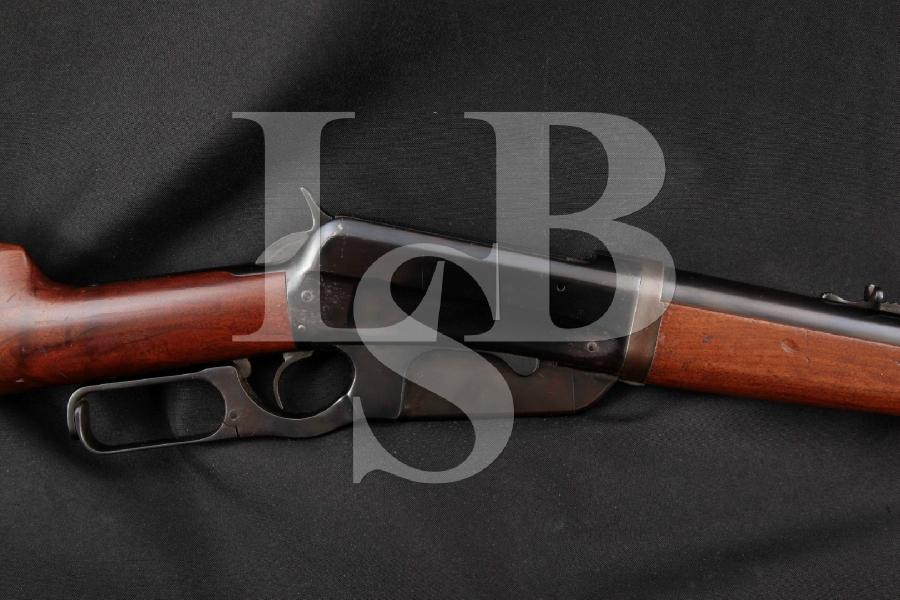
Winchester Model 1895 Takedown, Blue 24” Lever Action Rifle, MFD 1914 C&R
LSB#: 160430LW03
Make: Winchester
Model: 1895
Serial Number: 28126
Year of Manufacture: 1914
Caliber: .30-03 US
Action Type: Lever Action with Internal Box Magazine
Markings: The left side of the barrel is marked “NICKEL STEEL BARREL / ESPECIALLY FOR SMOKELESS POWDER”. The top of the barrel at the receiver is marked “.30 U.S. MOD. 1903.”. The left side of the receiver is marked “MANUFACTURED BY THE WINCHESTER REPEATING ARMS COMPANY. / NEW HAVEN, CONN. U.S.A. / PAT. NOV.5.95.NOV.12.95.AUG.17.97.JAN.25.98.AUG.23.98.MAY 28.07.AUG.6.07.”. The upper tang is marked “MODEL 1895 / WINCHESTER / TRADE MARK”. The lower tang is marked “71350”.
Barrel Length: The round barrel is about 24” in length.
Sights / Optics: The front sight is a brass bead dovetailed into a base fixed to the barrel. The rear sight is a semi-buckhorn elevator sight with a small “U” notch at the bottom that is dovetailed into the barrel.
Stock Configuration & Condition: The stocks are smooth walnut with a straight grip, lacquered finish and a Schnabel tipped forend with a black wedge inlet into the tip. There is blued steel crescent shaped buttplate mounted on the butt. There are several dings, shallow bruises, light scrapes, drag lines and handling marks in the buttstock with a deep compression mark on the left side. The forend show numerous light handling marks with a deep bruise on the right side and a very thin strip of white paint transferred onto the left side. The wood to metal fit is excellent. The LOP measures 13 7/8” from the front of the trigger to the back of the buttplate, which fits the butt well. The buttplate shows a few tiny spots of solid erosion at the heel, light wear at the heel and toe and a few light handling marks. It is in about Very Good condition. The stocks rate in about Very Good overall condition.
Type of Finish: The rifle is blued.
Finish Originality: The finish on the barrel appears original but the receiver has been refinished. The sides of the receiver are slightly uneven in spots and the metal around the screw heads are dished. The right lower shoulder of the receiver at the front of the trigger guard is rounded-off under the finish.
Bore Condition: The bore is gray with light wear in the rifling. There is light erosion the length of the bore. Our bore gauge measures a ME of 0.9.
Overall Condition: This rifle retains about 75% of its current metal finish. There are spots of rust showing near the muzzle and along the underside of the barrel from the muzzle to the forend. The barrel extension has developed a plum colored patina with scabs of solid erosion on its underside. There are tiny spots of solid erosion sprinkled over the sides of the receiver and magazine, the top of the bolt, and the lever. There are also a few small scratches on both sides of the receiver. The screw heads are sharp with a few having minor marks from a screwdriver. The markings are clear. Overall, this rifle rates in about Very Good condition as refinished.
Mechanics: The action functions correctly. The action is smooth and the lever locks up correctly. We have not fired this rifle.
Box, Paperwork & Accessories: None
Our Assessment: The 1895 Winchester was the first model to incorporate a non-detachable box magazine. This is the model Teddy Roosevelt called his “Big Medicine” that he used in hunting here and in Africa. This rifle became the preference of major powers worldwide, with Russia alone purchasing nearly 300,000 1895’s just before World War I. The Model 1895 was designed for the new generation of cartridges utilizing smokeless powder and pointed bullets, and many of its original chamberings remain popular today. With its quick handling characteristics, box magazine and pointed bullet capability, the Model 1895 changed the world of sporting rifles forever. The US .30-03 cartridge was developed in 1903 to replace the .30-40 Krag cartridge used in the Krag-Jorgensen rifles. The army wanted a faster, flatter shooting cartridge than the .30-40 and a rimless case that would feed better through a box magazine. The cartridge used a 220 grain round nosed bullet with a muzzle velocity of 2300 fps. While faster than the .30-40 cartridge, it still had a curved trajectory and was replaced in 1906 with the .30-06 utilizing a 150 grain spitzer bullet. The rifle is in about Very Good condition with 75% of its finish remaining. The remainder of the finish shows spots of in rust showing near the muzzle and along the underside of the barrel, with spots of solid erosion on the barrel extension, the sides of the receiver and magazine, and on the lever. There is also a plum colored patina formed on the barrel extension. The wood shows several dings, bruises and drag lines in the buttstock and numerous light handling marks in the forend. There is also a deep bruise on the right side of the forend and deep compression mark on the left side of the buttstock. The bore is gray with light wear in the rifling and light erosion sprinkled throughout the bore. Our bore gauge measures a ME of 0.9. This rifle is in great mechanical condition, especially for being over 100 years old.

